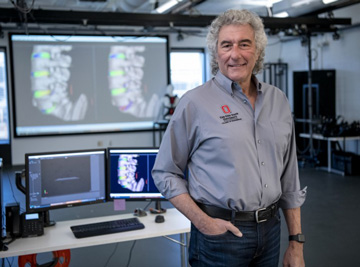Devices that generate objective data allow providers to tailor post-op treatments more safely and accurately.
 Ohio State News
Ohio State News
DIGITAL ASSISTANCE Dr. Marras believes the sensor will allow doctors to go beyond patients' subjective self-reports of post-op pain by quantitatively measuring their motions to better understand the biomechanics at work.
Engineering and medical researchers from The Ohio State University (OSU) are developing a digital health system approach that is designed to enhance the decision-making of providers who treat patients recovering from spine surgery.
These providers rely on their patients to let them know when they are feeling pain and discomfort, which can lead to numerous and potentially unnecessary expensive tests and treatments. "You simply can't only ask people how they feel about their back," says William Marras, PhD, CPE, executive director of the Spine Research Institute at OSU. "People are asked to rate how they feel on a scale of 1 to 10, but since you don't have pain receptors in the disc, what does that mean?"
The goal of the new OSU technology is to bring objective metrics to the table to better inform treatment decisions. Dr. Marras, whose lab has studied daily living forces on the spine for decades and developed the first wearable back sensor 30 years ago, says the team is working to enable providers to look at not only how people feel about their back pain, but also quantitatively measure how their motions are different and what that means in terms of biomechanics.
The OSU researchers believe that objective functional assessments may be a better indicator of when it's safe for patients to return to normal activities after spinal fusion surgery. "Our technology is able to look at, one, whether or not you have a back impairment, and two, what is its status?" says Dr. Marras. "Is it getting better, is it getting worse, is it progressing or is it off the scales? When you're doing damage to the back, and particularly the discs, you don't know when the damage occurs because we have very few nerve receptors in the disc. You could be doing damage and people would never know."
Take a deeper dive into the OSU project through the team's published study in Clinical Biomechanics.
.svg?sfvrsn=be606e78_3)


.svg?sfvrsn=56b2f850_5)